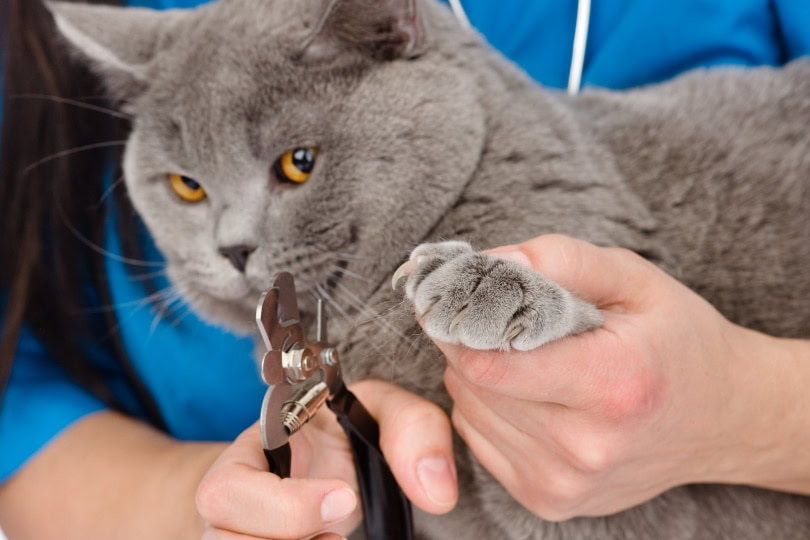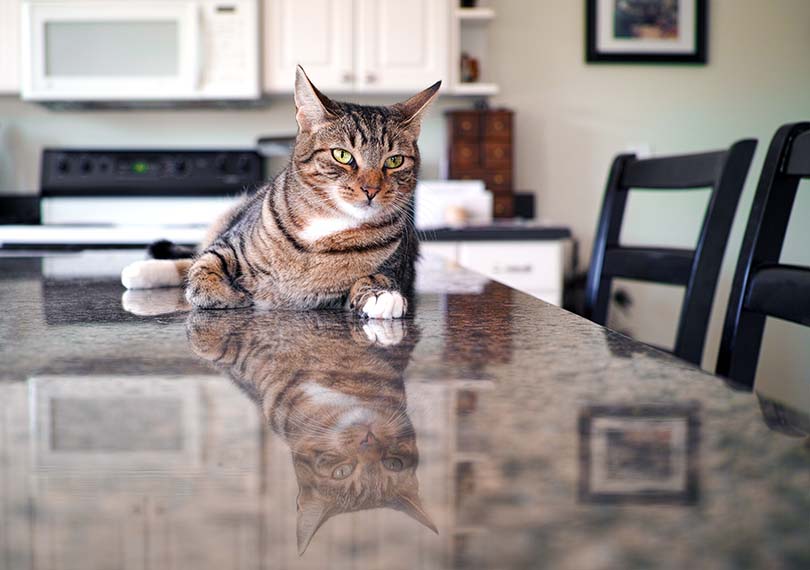VET APPROVED

The information is current and up-to-date in accordance with the latest veterinarian research.
Learn more »Click to Skip Ahead
Cats are amazing pets that provide lovable, furry companionship. However, not every part of owning a cat or a kitten is easy. As with any pet, you take on many responsibilities when you adopt them. These include giving them exercise, feeding them, and brushing them. You also have to work with them on any behavioral problems that they have. You need to have patience and willingness, as there’s no such thing as the perfect pet.
One of the most destructive and irritating behaviors that a cat can have is when they use their sharp little claws to scratch up your furniture. Why is your cat scratching your couch, and how do you stop this negative behavior?
This article covers the reasons that cats scratch, declawing your cat, the methods that you can use to control the behavior, and the steps to go from scratched couches to scratching posts.
Training behavioral issues out of a cat is a complex topic, for additional support and guidance we suggest consulting one of our vets.

Cats and Scratching Behavior
The best way to deal with undesirable behavior in any pet is to understand why they do it. If you can redirect that focus or change the need for the pattern, then it’s generally a much faster process.
Cats are natural scratchers. It’s essential to understand that you aren’t trying to train out their instinct to scratch, you just want to redirect their attention away from the furniture.
In the wild, they need to scratch to communicate with others and to keep their claws in good shape. House cats have the same instincts.
- Maintaining Claw Health
House cats need to maintain the health of their claws. Scratching on rough surfaces does the same for domestic cats as those in the wild, helping them shed those pesky nail husks.
- Stretching
Just like grabbing our feet for tension in a yoga stretch can help us stretch deeper, cats will bare their claws in a stretch to better extend their tendons and muscles from the neck to the shoulders.
- Marking
Another instinctive reason for scratching is a cat’s need to communicate with others by releasing pheromones and marking their territory. Scent glands in a cat’s paws release chemical signals on things they claim as “theirs.” It’s part of the feline social structure, even if there is only one cat in your household.
- Getting a Satisfying Feeling
Finally, why do cats do anything? Because they want to. Scratching feels pleasant for cats. It functions as a natural stress reliever and a fun way to play, climb, or fight with other household felines.
Should You Declaw Your Cat?
The “easy” solution for some cat owners over the last several decades has been to declaw their cats. That way, they literally can’t scratch the couch.
Fortunately, this practice is getting less and less common with time. Declawing a cat is a painful and challenging procedure that can present many future problems for your cat and you.
The procedure to declaw a cat involves amputating the last phalanx on each of their toes so their claws will never regrow. It is the same idea as taking off each of your fingers’ last segments so your nails would never grow back. You would still be able to use your hands, but you would have less finger length and no nails.
There are several long-term problems associated with cat declawing. A 2023 study showed that it has a direct negative impact on the muscles of a cat’s legs. After declawing they can also suffer from infections, lameness, and back pain.
Declawing has been banned as an inhumane act in many countries and made illegal throughout various cities in the U.S.
Although declawing can be a choice as a cat owner in some parts of the U.S. where it’s still legal, there are other methods that you can use if you want to train your cat to not scratch your couch and other furniture.
Keeping your cat's nails trimmed is important, but it's no one's favorite task. You can make it easier with great clippers designed specifically for cats. We like Hepper's Cat Nail Clipper Set, a convenient combination of medium and small clippers that comes in a handy pouch. These sharp stainless steel clippers allow for precision trimming, with the added protection of built-in safety guards. Plus, there's a hidden nail file!
At PangoVet, we've admired Hepper for many years, and decided to take a controlling ownership interest so that we could benefit from the outstanding designs of this cool cat company!

The 4 Methods to Stop a Cat From Scratching Your Couch and Other Furniture
We start with a few methods and different kinds of products that people often use in the training process. Often, these are only necessary during training. Once your cat learns where to direct their scratching, you won’t have to worry about continually wrapping or spraying your furniture.
1. Provide Them With a Scratching “Outlet”
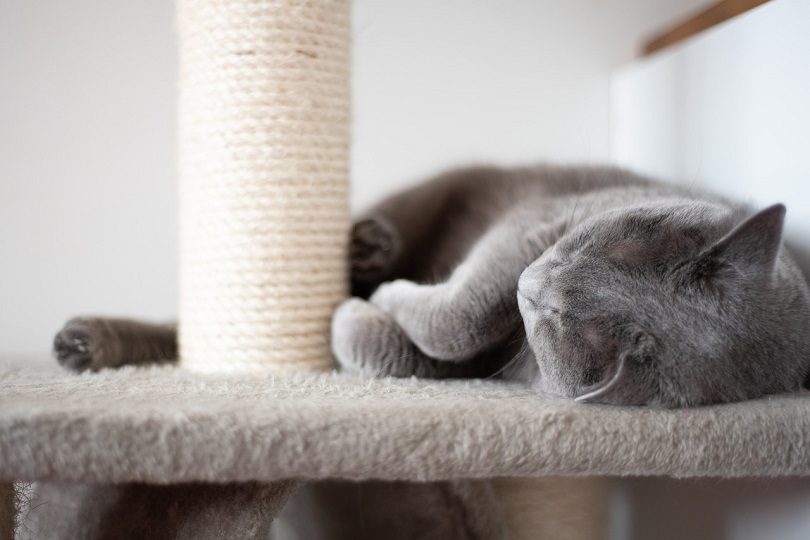
It’s essential to provide cats with suitable scratching posts and surfaces to redirect their scratching instincts. This is an ingrained and entirely natural tendency.
Scratching posts are the most common outlets that people give their cats and are essential to their training.
The Hepper Hi-Lo Cat Scratcher features a modern and clever design that offers cats an appealing place to scratch – and a way to keep them from scratching all the things they shouldn't. Unlike most cat toys (where your cat probably just prefers the cardboard box they came in), cat's flock to this design ... maybe it's because there's cardboard in it!
- Premium Materials - Hepper's cardboard scratcher is made with dense, B-flute cardboard, and a metal...
- High, Low and Lower - A single cat scratch pad won't keep your cat engaged. 3 unique positions keeps...
- Activates Muscles - The Hi Lo isn't just a cat nail file to stop the chief cat couch scratcher. The...
With its 3-position setup, textured cardboard, and sturdy frame, it encourages their natural scratching behavior, steering them away from clawing at items like furniture, walls, carpets, curtains, and people. The Hi-Lo is a reliable solution to safeguard your home and create a more enjoyable environment for your cat, all while looking modern and stylish.
At PangoVet, we've admired Hepper for many years, and decided to take a controlling ownership interest so that we could benefit from the outstanding designs of this cool cat company!
- Related read: DIY Cat Scratching Posts You Can Build Today
2. Use Cat-Scratch Tape
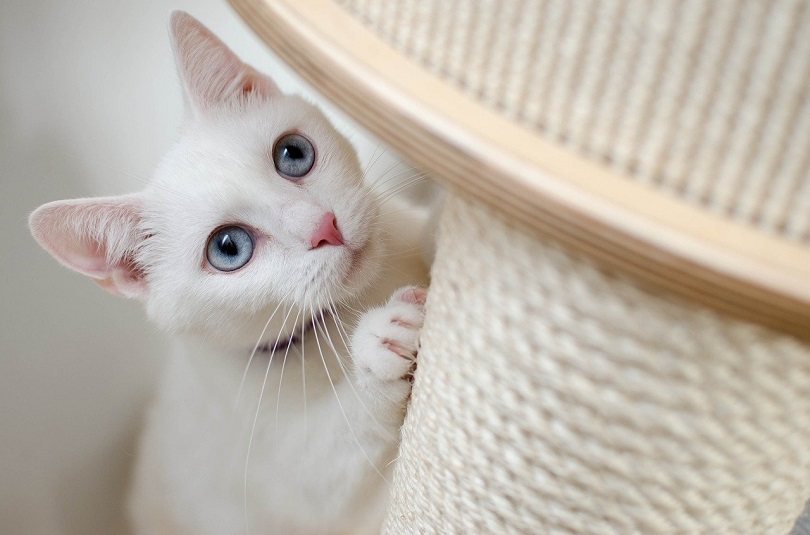
Cat-scratch tape is useful for making furniture unappealing to your cat. Felines are texture-sensitive, especially on their paws. A cat enjoys scratching. They do it partially because it feels good
Putting cat-scratch tape on furniture makes it unappealing for a cat to scratch. You should put it right over the spot that they usually target, so their paws will run across it as they go.
Remember that all cats are different. Some hate the feeling of the tape, while others won’t mind it. Luckily, it’s a small investment to make even if the trial doesn’t go ideally.
3. Use Pheromones
One way to get your cat to avoid the furniture is to determine the desired scratching surface and apply a product specifically designed for this purpose, such as Feliscratch by Feliway. Apply it to the desired area to send a message to the cat that encourages them to scratch there.
4. Install Vinyl Panels
Directly protect your couch by temporarily installing vinyl panels that cover the sides of the furniture. Putting these around the furniture will not look great, but you should only have to do it while you train your cat.
Vinyl panels make the sides of your couch inaccessible to your cat’s dangerous nails. Even if they do try to scratch, nothing should happen to the fabric on the other side.

How to Stop a Cat From Scratching Furniture
Whenever you train a behavior into or out of one of your pets, you must have patience. It can sometimes take a while to change and redirect an instinctive action, especially if you waited a while to do anything about it.

Stopping and starting your training will exponentially increase the time that the process takes. Trying something once without positive results is not indicative of the result. Instead, try something consistently for a couple of weeks before attempting something new. If you notice any positive behavioral change, even a small one, then reward it.
1. Purchase the Right Scratching Post
Start the process by purchasing at least two different scratching posts. If you can, try to find one that mimics the fabric of their favorite area to scratch. You already know that they like that texture, so it is less of a risk.
You may have to try several posts out in the long run, especially if you have more than one cat. However, give each one time before swapping it out, or you may confuse the cat.
2. Place the Scratching Post Strategically
The next step is to place the scratching post in the right spot to help make it appealing to your animal.
Choose a place that your cat already likes to be. This special area could be near their favorite spying window or in the room where the family hangs out if your cat is sociable.
If you notice your cat coming over to investigate the new post, even from afar, reward them. You want them to associate this scratching post with positive things. The more they interact with it, the more you should praise and reward them.
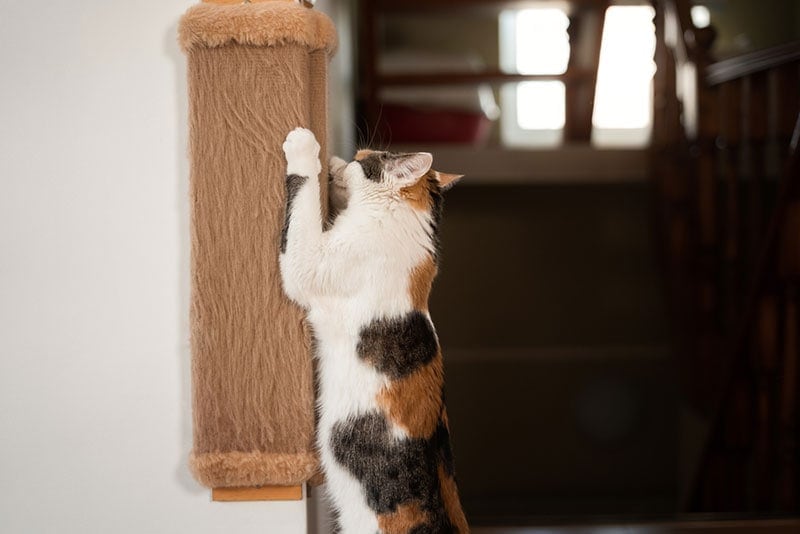
3. Make the Furniture Temporarily Unattractive
The next step is to make the couch unattractive to them. Use cat tape or vinyl lining to make it unappealing. Then, when they want to scratch, they will hopefully turn to the scratching post.
If they go to a different piece of furniture, repeat the protection process until their only satisfying option is the scratching post.
4. Build Interest in the Scratching Post
Once you have made their primary scratching area unappealing, make the scratching post as exciting as possible. You can sprinkle it with catnip or use their favorite toys to direct them toward the post. Have them chase a wand toy up the post so they can feel how great it is on their claws.
5. Deploy Extra Furniture Safety Measures If Necessary
If your cat is still trying to scratch the furniture, continue to make more of the furniture unattractive by combining the previous methods.
At the same time, make the scratching post as attractive as possible. Try moving it to a better area or keeping it out in the center of the room until they become attached to it — somewhat literally.
6. Enjoy Your Scratch-Less Couch
Once it is firm in your cat’s mind that the couch is not a fun place to scratch and the scratching post is the best, you can take off the protective measures one at a time. Don’t do this too early, so your cat doesn’t see their primary option returned to its “fun” state again. Before you entirely remove the protections, their favorite choice should have become the post.
When they are finally best friends with the post, you can sit back and relax. Don’t let the post get too ratty, though, or they won’t want to keep using it. It is best to replace the post with the same product, so you don’t test their texture tolerance, and all should be well in the world of your furniture.

Conclusion
Redirecting your cat’s scratching behavior takes patience, consistency, and the right guidance. While scratching is an instinct for cats, you can still guide them toward appropriate outlets like scratching posts while protecting your furniture with deterrents. Avoiding declawing ensures your cat stays healthy and pain-free, while training methods can make a huge difference in their behavior. By understanding your cat’s needs and finding alternate activities for your cat, you’ll create a home where you and your kitty can live happily, without scratched couches.
Related Reads:
- How to Trim Your Cat’s Nails at Home
- How to Protect Your Cat’s Paws From Hot Pavement
- Are Nail Caps Safe for Cats?
Featured Image Credit: Ermolaev Alexander, Shutterstock
